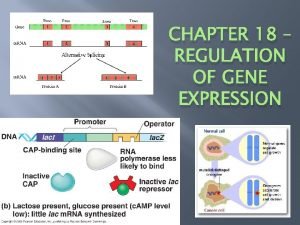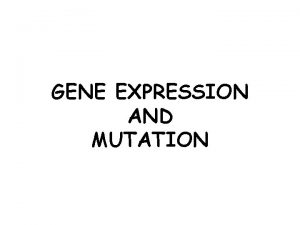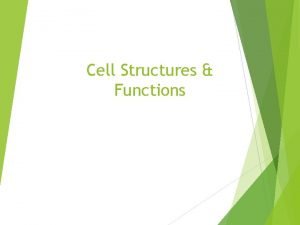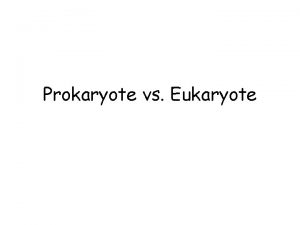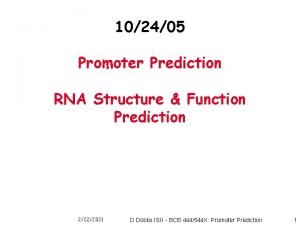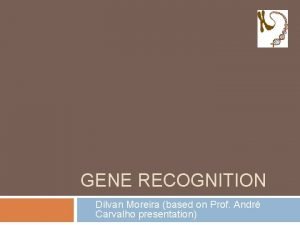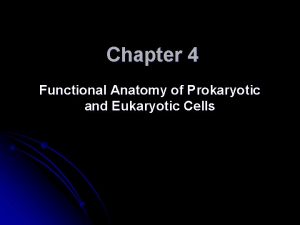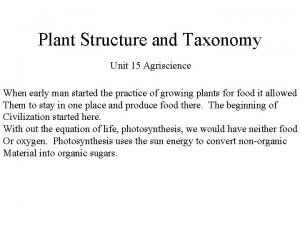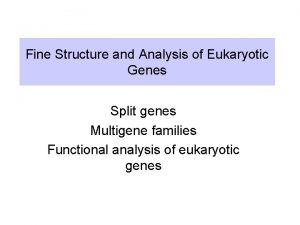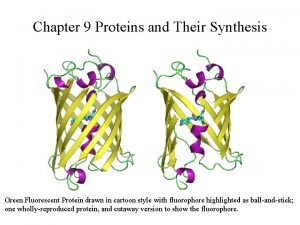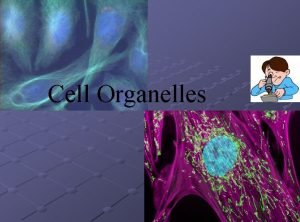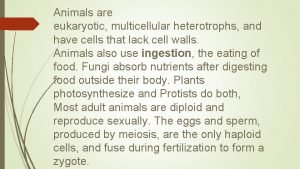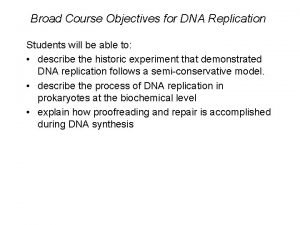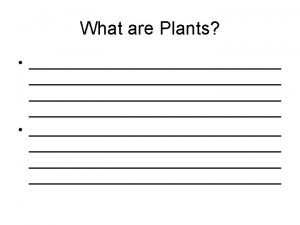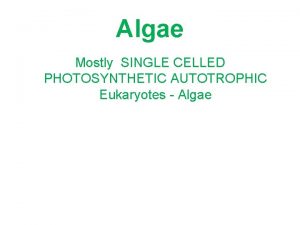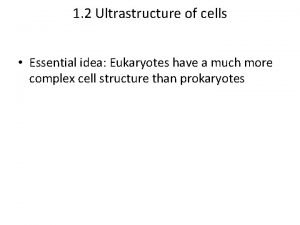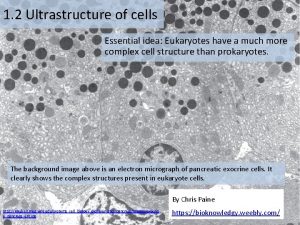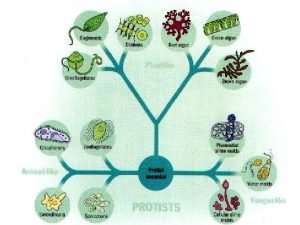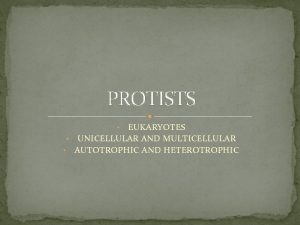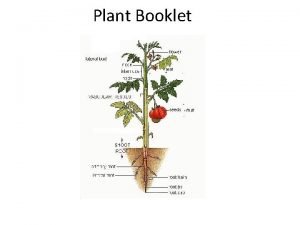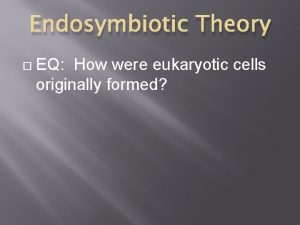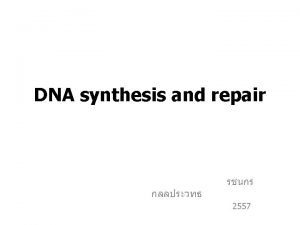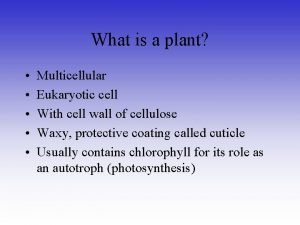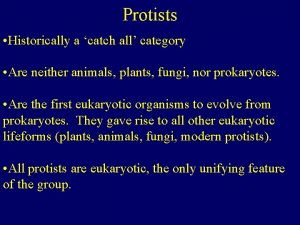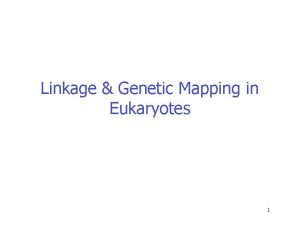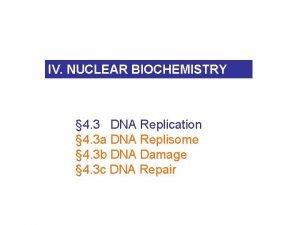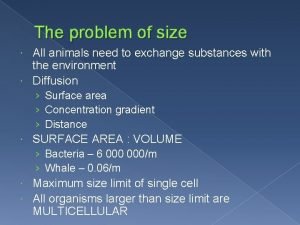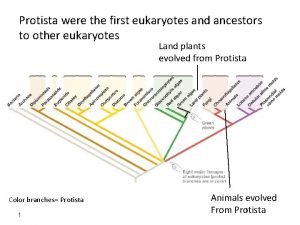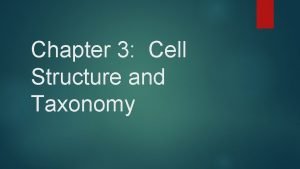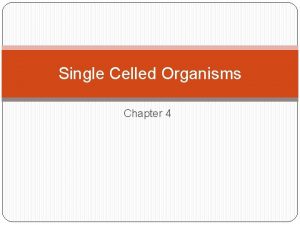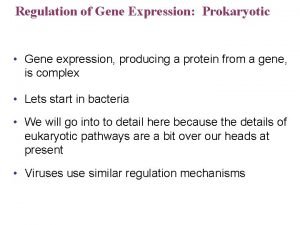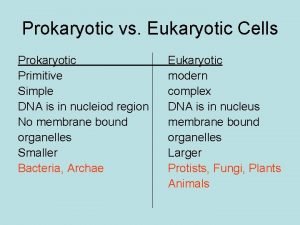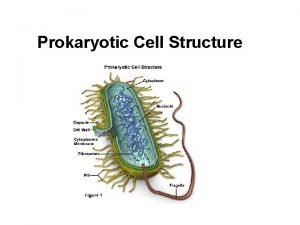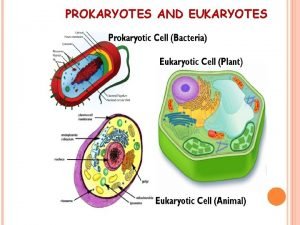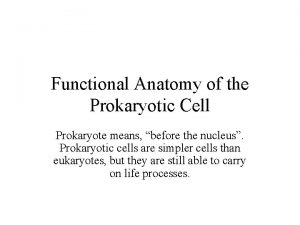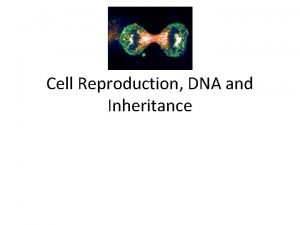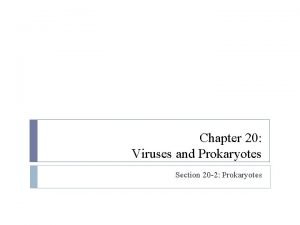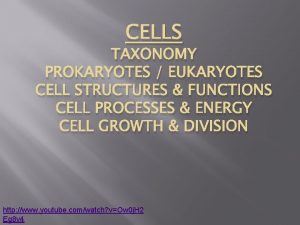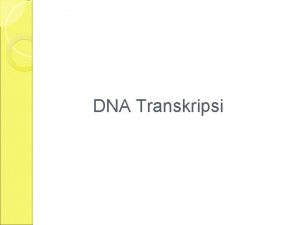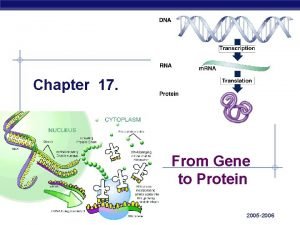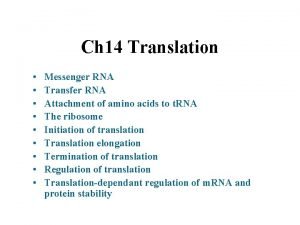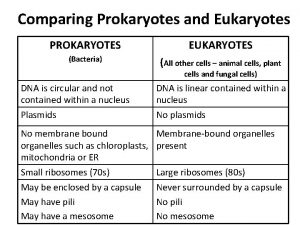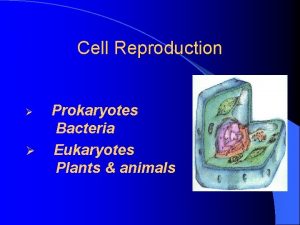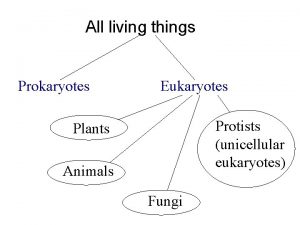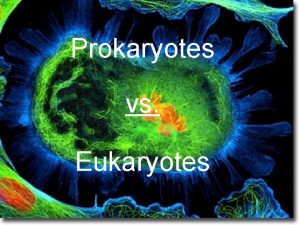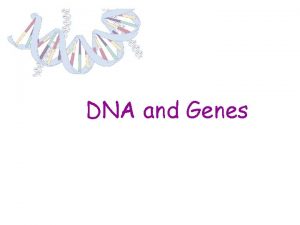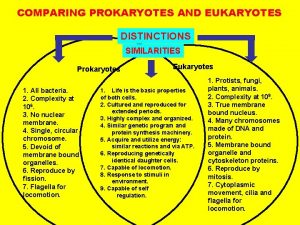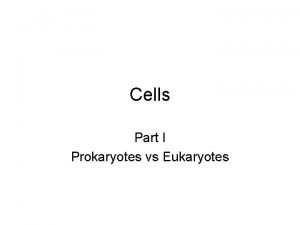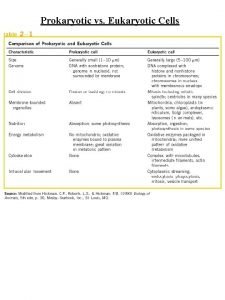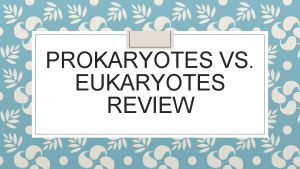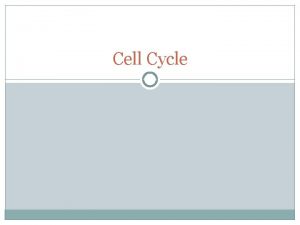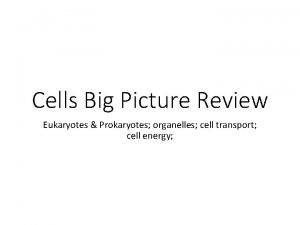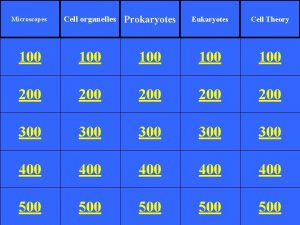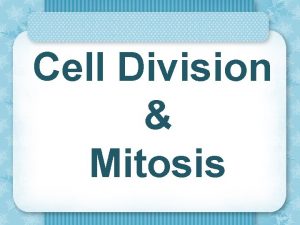CELLS TAXONOMY PROKARYOTES EUKARYOTES CELL STRUCTURES FUNCTIONS CELL










































































- Slides: 74

CELLS TAXONOMY PROKARYOTES / EUKARYOTES CELL STRUCTURES & FUNCTIONS CELL PROCESSES & ENERGY CELL GROWTH & DIVISION http: //www. youtube. com/watch? v=Ow 0 j. H 2 Eg 8 v 4

Review What are the eight characteristics of living things? � What are the four major macromolecules? �

Answers � 1. Made up of cells 2. Reproduce 3. Maintain Homeostasis 4. Metabolism 5. Evolution /Adapt 6. Respond to Stimuli 7. Grow and Develop 8. DNA � Carbohydrates, Proteins, Lipids, and Nucleic Acids � � � �

Diversity of Life � � Arises by evolutionary change leading to the present biodiversity we see. Divided into Three Domains: � 1. Bacteria- single celled prokaryotes (no nucleus) � 2. Archaea- single celled prokaryotes (no nucleus) � 3. Eukarya- Plants and Animals, complex organelles and multicellular

Three Domains & Six Major Kingdoms DOMAINS � � � Bacteria Archaea Eukarya KINGDOMS � � � Eubacteria Archaea Animalia. Animals Plantae- Plants Fungi- Fungus Protista- animal like and plant like

Domain Eubacteria � � True bacteria, mostly heterotrophic, live in all sorts of environments Largest groups of organisms on Earth Only a small amount are disease causing Most have very important roles: � Photoautotrophs such as cyanobacteria � Saprophytes- decomposers that break down dead material. � Symbionts- they have a relationship with other organisms

Domain Archaea � � � Most recent domain, 1970’s Live in extreme environments with high temperatures and some produce methane. Vast difference in genetic and biochemical make-up from other bacterium. Microscopically similar in looks so it is likely that it has been around for a long time but we just missed it. Live in extreme environments � Hot springs, hydrothermal vents, extremely acidic or alkaline water, anoxic mud swamps, petroleum deposits, and the digestive tracts of cows, termites, and marine life where they produce methane.

Salt Loving- Halobacterium � Has a pigment that makes it purple called bacteriorhodopsin, which also helps it synthesize ATP. San Francisco Bay http: //www. newscientist. com/article/dn 2057 7 -hidden-ecologies-salt-ponds-andentombed-marshes. html#. VB 97 I 1 e. KVEM

Domain Eukarya � � Eukarytotes= have a nucleus, are unicellular and multicellular 4 Kingdoms � 1. Kingdom Protista: unicellular eukaryotes, multicellular algae (dinoflagellates, diatoms, etc) � 2. Kingdom Plantae: have cells walls, cellulose, and obtain energy through photosynthesis. � 3. Kingdom Fungi: Cell walls are made of chitin, obtain energy by secreting enzymes and absorb the products they release. � 4. Kingdom Animalia- no cell walls, obtain energy by ingesting other organisms.

How are organisms in the kingdoms classified? ? � � � Carl Linnaeus (1707 -1778) He came up with a means of naming organisms that was simple and universal. Problem- before this people were naming organisms multiple names that were really long, and there wasn’t any consistency. Taxonomy- science of classifying organisms and assigning each organism a universally accepted name. Linnaeus came up with binomial nomenclature-> two word naming system � Genus, species � Always in italics � Genus is capitalized � Ex- Homo sapiens and species lowercased

Classification System � � � � Domain Kingdom Phylum Class Order Family Genus Species Dear King Phillip Came Over From Great Spain!!!!

Prefixes Cyto= cell � Iso= Equal � Kary= Kernel � Hyper= Above � Endo= Within � Hypo= Below � Exo= Out of �

How did we learn that there were different cells, three Domains, etc?

Robert Hooke � � First to identify cells by observing cork from the bark of an oak tree. 1665

Anton Van Leewenhoek Described living things and observed them in greater detail. � Called them “animalcules” � 1674 �

Matthias Schleiden Found that plants are made of cells � 1838 �

Theodore Schwann � � All living things are made of cells 1839

Rudolf Virchow � � Proposed that cells come from preexisting cells 1855

Three Major principles of the cell theory � � � 1. All organisms are made of cells 2. All existing cells come from pre-existing cells 3. Cells are the basic unit of life.

Short Video with Notes � http: //ed. ted. com/lessons/the-wacky-history-ofcell-theory#watch

What is the relationship between structure and function of your cells? � The way they are shaped directly relates to their job or function. http: //www. youtube. com/watch? v=u 54 b. Rp b. SOgs

Examples � � 1. Long, thin nerve cells transmit sensory info from your brain to the rest of your body. 2. Short, blocky skin cells that cover and protect the body.

Nerve Cells

http: //www. pinterest. com/pin/32088216071181270/

White blood cell engulfing a bacteria cell and spewing out the remnants http: //www. nature. com/naturejobs/2013/13 0815/images/nj 7462 -367 a-i 1. 0. jpg

http: //io 9. com/photos-of-the-amazing-andgruesome-world-under-a-micros 1291328130 Inside the chloroplast of a plant cell

Eyelashes! http: //www. ebaumsworld. com/pictures/view/83877873/

Bacteria on the tongue http: //www. ebaumsworld. com/pictures/view /83877873/

Artery and blood cells http: //www. ebaumsworld. com/pictures/view /83877873/

Clump of sperm tails in the testes http: //www. ebaumsworld. com/pictures/view /83877873/

Staphylococcus bacteria in the trachea http: //www. sciencephoto. com/media/12812 /enlarge

Liver cell http: //www. sciencephoto. com/media/31023 2/enlarge

Lung Cells http: //images. sciencesource. com/preview/1 4917208/SQ 7335. html

� � http: //www. youtube. com/watch? v=HNP 1 EAYLh Os&feature=fvwrel http: //www. youtube. com/watch? v=Rpj 0 em. EGS h. Q&feature=related

Cells are separated into two categories � 1. Prokaryotic � 2. Eukaryotic

Prokaryotes � No � nucleus or membrane bound organelles � DNA is suspended in the cytoplasm and circular � Single celled � Cell Walls � Evolved 3. 5 bya � Ex- Bacteria or Archaea Divided into groups based on their need for oxygen: � Obligate anaerobes- cannot survive in the presence of oxygen. � Obligate aerobe- needs oxygen to survive � Facultative aerobe- can survive whether or not oxygen is present.

Structure of a Prokaryote Cytoplasm Cell membrane Pili Cell Wall www. biologyjunction. com DNA Ribosomes Flagella

Functions � � � � Pili- help prokaryotes stick to the surfaces Flagellum- tail like structure used for movement. Plasmid- small piece of DNA that replicates separately from the main chromosome. DNA- shaped in a loop or circle and is located in the cytoplasm. Cytoplasm- jellylike substance that surrounds molecules and organelles in a cell Cell wall- structural support Cell membrane- controls the movement of substances in and out of the cell.

Benefits of Prokaryotes � � � Provide nutrients to humans and animals, especially in digestion. Bacteria have a symbiotic relationship called mutualism where both the host and bacteria benefit. The bacteria has a home and obtains food from the host while at the same time the bacteria helps the host by breaking down foods and helping them absorb nutrients and vitamins. Important in the ecosystem- some produce oxygen while others help cycle carbon, hydrogen, nitrogen, and phosphorus through the environment. Bioremediation- using living things to break down pollutants. Some bacteria can digest oil= clean up oil spills.

Bacterial Diseases � Can attack the cells in tissues. � Tuberculosis / TB, is caused by a bacteria that invades the lungs and uses the tissues for nutrients � Can make poisons called toxins � Blood carries it to other parts of the body. � Food poisoning

E. coli bacteria on a lettuce leaf http: //io 9. com/photos-of-the-amazing-and-gruesome-world-under-amicros-1291328130

Antibiotics � Antibiotics are used to fight bacterial disease � Chemicals that kill or slow the growth of bacteria � Work by stopping the cell wall from developing, animal cells don’t have cell walls, viruses also lack cell walls � When you take antibiotics it can kill the good bacteria= illness � Antibiotic Resistance: Overuse of the antibiotics has caused certain strains of bacteria to become resistant to medications, which allows the bacteria to survive and reproduce and pass the genetics on.

Eukaryotes �Has a nucleus with membrane bound organelles �Nucleus store the genetic material and is linear �Multicellular or unicellular �Larger, more complex �Plants and animals �Evolved 1. 5 mya

Both * Microscopic in size * Composed of similar building blocks * Cell Membrane * Cytoplasm * Have DNA * Loaded with ribosome's


Levels of organization � Ranges from smallest to largest Level Cell Organelle Cell Tissue Function Example Tiny organelles that each have specific functions. Mitochondria Basic unit of life. Plant or Animal Cell A group of similar cells that work together. Muscle Tissue Organ Collection of tissues joined together Lungs Organ System Organism Collection of organs that work together for a similar goal. Respiratory System A living thing Human

Cell Differentiation Defined- Process where a generic cell develops into a specific type of cell. � Example-> zygote -> embryo � �Allows germ cells, stem cells, and somatic cells to develop and mature.

Why is it crucial? � Crucial for embryonic development, plays a role in the functioning of many organisms throughout their lives.

Cell Organelles http: //www. youtube. com/watch? v=r. ABKB 5 a. S 2 Zg&feature=related

Cell Membrane � � Description- Thin covering, protects cells, made up of two layers- hydrophobic fatty acid tails and hydrophilic glycerol / phosphate heads Function- Controls the passage into and out of the cell, semi-permeable= some things come in and some things go out.

Cytoplasm � � Description- Jellylike substance throughout the cell Function- Cushions organelles, transports proteins, nucleic acids, minerals, and ions

Cytoskeleton Description- Network of proteins that is constantly changing to meet the needs of a cell. � Function- Protects, structural support and shape �

Three Main Fibers: � � � 1. Microtubules= long hollow tubes. Give cells its shape and acts as “tracks” for organelle movement. 2. Intermediate filaments- give a cell its strength 3. Microfilaments- tiny threads that allow the cell to move and divide. Help the muscle contract and relax.


Cell Wall � � � Description- Plants only, made up of cellulose, rigid, tough Function- Protects, supports, and shapes the cell. Process- Turgor Pressure

Vacuole � � � Description- Fluid filled sacs Function- Full of water, nutrients, and waste that is on its way out. Process- Storage

� � � Central Vacuole Description- Large fluid filled sac in plants only Function- Used for storage of materials needed by the cell such as water, food, enzymes, and inorganic molecules. Process- Storage

� � � Chloroplast Description- Plants only, green structure with chlorophyll Function- Carry out photosynthesis by capturing and converting solar energy. Process- Photosynthesis

� � � Vesicle Description-Small sacs that divide some materials from the cytoplasm Function- transport materials from place to place in a cell through the cytoplasm Process- Exocytosis and Endocytosis

Chromatin � � � Description- In the nucleus, made of DNA and protein, contains genes Function- To package DNA into a smaller volume so that it can fit into a cell. Process- Cell Division

Nucleus Description- Dense, ball shaped structure, contains DNA, Storehouse of the DNA � Function- Protein synthesis occurs here, control center of the cell � Process-Processes DNA and Protein Synthesis �

Nucleolus � � � Description- Dense region in the middle of the nucleus, dark ball Function- Ribosome's are made here Process- Protein Synthesis

Nuclear Membrane/ Envelope � � Description- Double membrane around the nucleus Function- Protects the nucleus and has pores around it for molecules to pass in and out

Nuclear Pore � � Description- little holes around the membrane of the nucleus Function- Allows things to move in and out of the nucleus.

Smooth Endoplasmic Reticulum � � � Description- No ribosomes, Lots of folds, inner membrane= lumen Functions- Makes proteins and lipids, controls calcium levels in muscles, breaks down drugs and alcohol Process- Detoxification, Synthesis of Carbs and Lipids

Rough Endoplasmic Reticulum � � � Description- Covered in ribosomes and attached to the nucleus Function- Produces, transports enzymes and proteins throughout the cell. Process- Processing Proteins

Ribosomes Description- tiny little balls throughout the cell. � Function- Makes proteins and RNA, tiny balls that link amino acids together to form proteins, site of protein synthesis � Process- Protein Synthesis �

Centrosome � � � Description- Small region of cytoplasm that produces microtubules, contains centrioles. Function- During mitosis this divides and the two parts move to opposite sides of the cell. Process- Cell Division

Golgi Apparatus � � � Description- Small bags with tubes connecting them and contains enzymes Function- Processes, sorts, packages, and delivers proteins and carbohydrates into vesicles for export out of the cell. Process- Processes Proteins

Mitochondria � � � Description- kidney bean shaped organelle Function- Supplies energy to the cell, converts food into energy (glucose into ATP), have their own ribosomes and DNA Process- Cellular Respiration

Centriole � � � Description- small cylinders Function- Helps divide DNA during cell division Process- Mitosis / Meiosis

Lysosomes � � � Description- Small, round structures that contain enzymes Function- Contains digestive enzymes, nutrients and old cells are broken down and digested, and defend a cell from invading bacteria and viruses. Process- Digestion, Phagocytosis

Flagella and Cilia � � � Description- flagella = tail-like, cilia= hair-like Function- Help the cell move Process- Movement

Videos � � http: //www. youtube. com/watch? v=LP 7 x. Ar 2 FDF U&feature=related http: //www. cellsalive. com/cells/cell_model. htm
 Gene expression in prokaryotes and eukaryotes
Gene expression in prokaryotes and eukaryotes Eukaryotes vs prokaryotes
Eukaryotes vs prokaryotes Prokaryotes vs eukaryotes gene regulation
Prokaryotes vs eukaryotes gene regulation Prokaryotes vs eukaryotes venn diagram
Prokaryotes vs eukaryotes venn diagram Diff between prokaryotes and eukaryotes
Diff between prokaryotes and eukaryotes Prokaryotes and eukaryotes
Prokaryotes and eukaryotes Is protist a prokaryote or eukaryote
Is protist a prokaryote or eukaryote Eukaryotic vs prokaryotic cell
Eukaryotic vs prokaryotic cell Prokaryotes vs eukaryotes
Prokaryotes vs eukaryotes Multiple choice questions on prokaryotes and eukaryotes
Multiple choice questions on prokaryotes and eukaryotes Gene prediction in prokaryotes and eukaryotes
Gene prediction in prokaryotes and eukaryotes Prokaryotic and eukaryotic cells chart
Prokaryotic and eukaryotic cells chart Polimerase
Polimerase Prokaryotic cell
Prokaryotic cell Are red blood cells prokaryotic or eukaryotic
Are red blood cells prokaryotic or eukaryotic Anatomy of prokaryotes and eukaryotes
Anatomy of prokaryotes and eukaryotes Marzano new taxonomy
Marzano new taxonomy Cell structure and function graphic organizer
Cell structure and function graphic organizer Parts of a cell graphic organizer
Parts of a cell graphic organizer Unit 15 plant structures and taxonomy
Unit 15 plant structures and taxonomy Paranasal sinus development
Paranasal sinus development Dr saja
Dr saja Parafollicular cells vs follicular cells
Parafollicular cells vs follicular cells Gametic cells vs somatic cells
Gametic cells vs somatic cells Somatic cells vs germ cells
Somatic cells vs germ cells Red blood cells and white blood cells difference
Red blood cells and white blood cells difference Comparing animal and plant cells venn diagram
Comparing animal and plant cells venn diagram The organelle trail
The organelle trail Masses of cells form and steal nutrients from healthy cells
Masses of cells form and steal nutrients from healthy cells Pseudostratified vs simple columnar
Pseudostratified vs simple columnar Are plant cells prokaryotic or eukaryotic
Are plant cells prokaryotic or eukaryotic Chapter 8 cellular reproduction cells from cells
Chapter 8 cellular reproduction cells from cells Cell substance
Cell substance Homologous structures
Homologous structures Multicellular definition
Multicellular definition Rna polymerase
Rna polymerase Characteristics of eukarya
Characteristics of eukarya Fine structure analysis of eukaryotes
Fine structure analysis of eukaryotes Translation in bacteria vs eukaryotes
Translation in bacteria vs eukaryotes Difference between prokaryote and eukaryotes
Difference between prokaryote and eukaryotes All animals are multicellular heterotrophs
All animals are multicellular heterotrophs Prokaryotic
Prokaryotic Linear chromosomes in eukaryotes
Linear chromosomes in eukaryotes Plants are multicellular eukaryotes
Plants are multicellular eukaryotes How many dna polymerase in eukaryotes
How many dna polymerase in eukaryotes Types of dna polymerase in eukaryotes
Types of dna polymerase in eukaryotes Is fucus autotrophic or heterotrophic
Is fucus autotrophic or heterotrophic Eukaryotes main idea
Eukaryotes main idea Eukaryotes main idea
Eukaryotes main idea Protozoa are polyphyletic
Protozoa are polyphyletic Is protista autotrophic or heterotrophic
Is protista autotrophic or heterotrophic Plants are multicellular eukaryotes
Plants are multicellular eukaryotes Anaerobic bacteria
Anaerobic bacteria Dna polymerase proofreading
Dna polymerase proofreading Plants are multicellular eukaryotes
Plants are multicellular eukaryotes Sarcodinia
Sarcodinia Genetic linkage and mapping in eukaryotes
Genetic linkage and mapping in eukaryotes In eukaryotes dna replication occurs in
In eukaryotes dna replication occurs in Heterogamy in eukaryotes
Heterogamy in eukaryotes The first eukaryotes were
The first eukaryotes were Plants are multicellular eukaryotes
Plants are multicellular eukaryotes Cell structure and taxonomy
Cell structure and taxonomy Single-celled prokaryotes
Single-celled prokaryotes Lac operon in prokaryotes
Lac operon in prokaryotes Parasitism
Parasitism Mesosomes in bacteria
Mesosomes in bacteria The oldest prokaryote is
The oldest prokaryote is Characteristics of a prokaryote
Characteristics of a prokaryote Nonliving particle that replicates inside a living cell
Nonliving particle that replicates inside a living cell Crossing over during prophase 1
Crossing over during prophase 1 Chapter 20 viruses and prokaryotes
Chapter 20 viruses and prokaryotes King phillip came over from great spain
King phillip came over from great spain Termination of transcription in prokaryotes
Termination of transcription in prokaryotes Transcription in prokaryotes
Transcription in prokaryotes Upstream open reading frame
Upstream open reading frame


